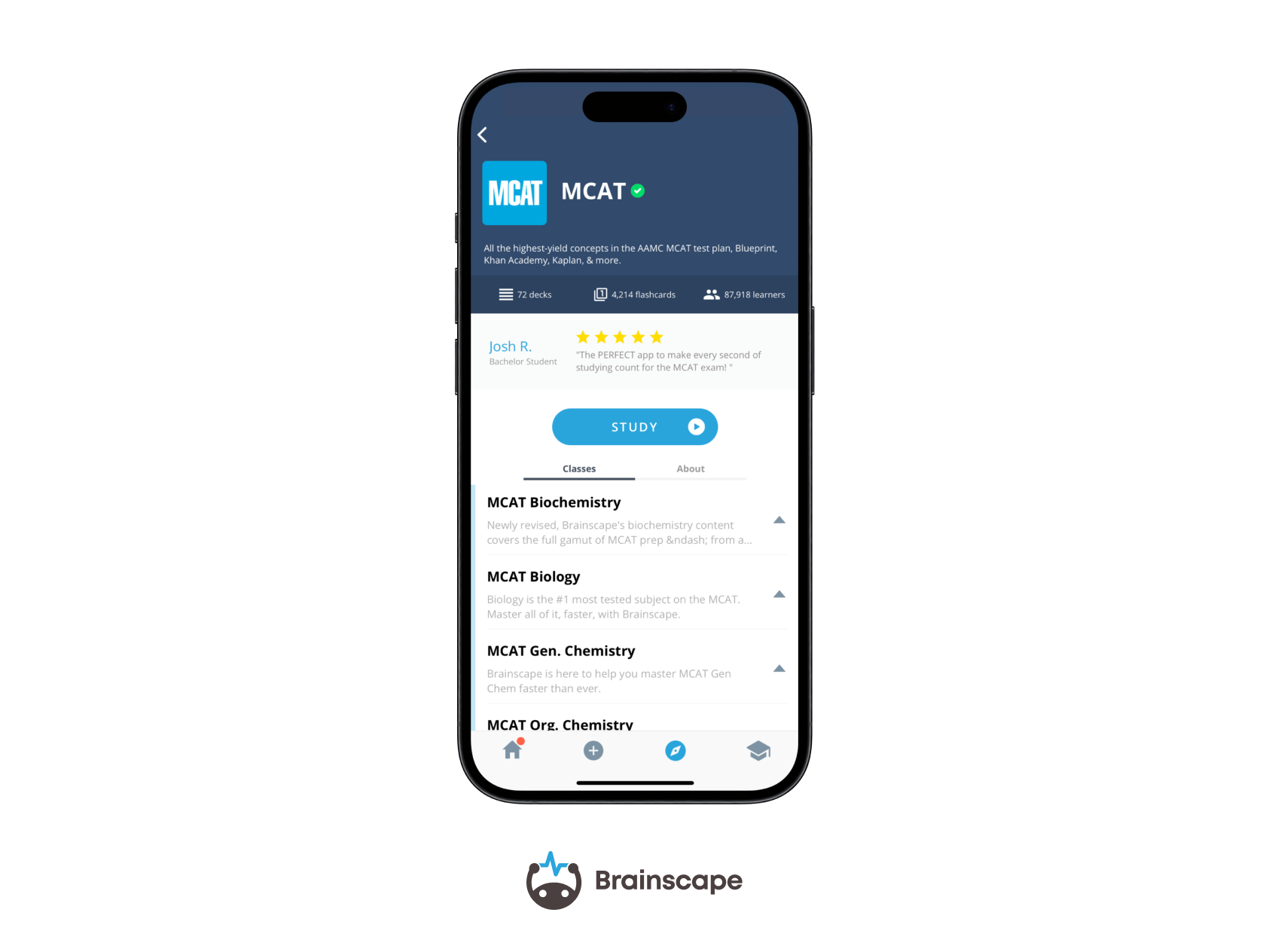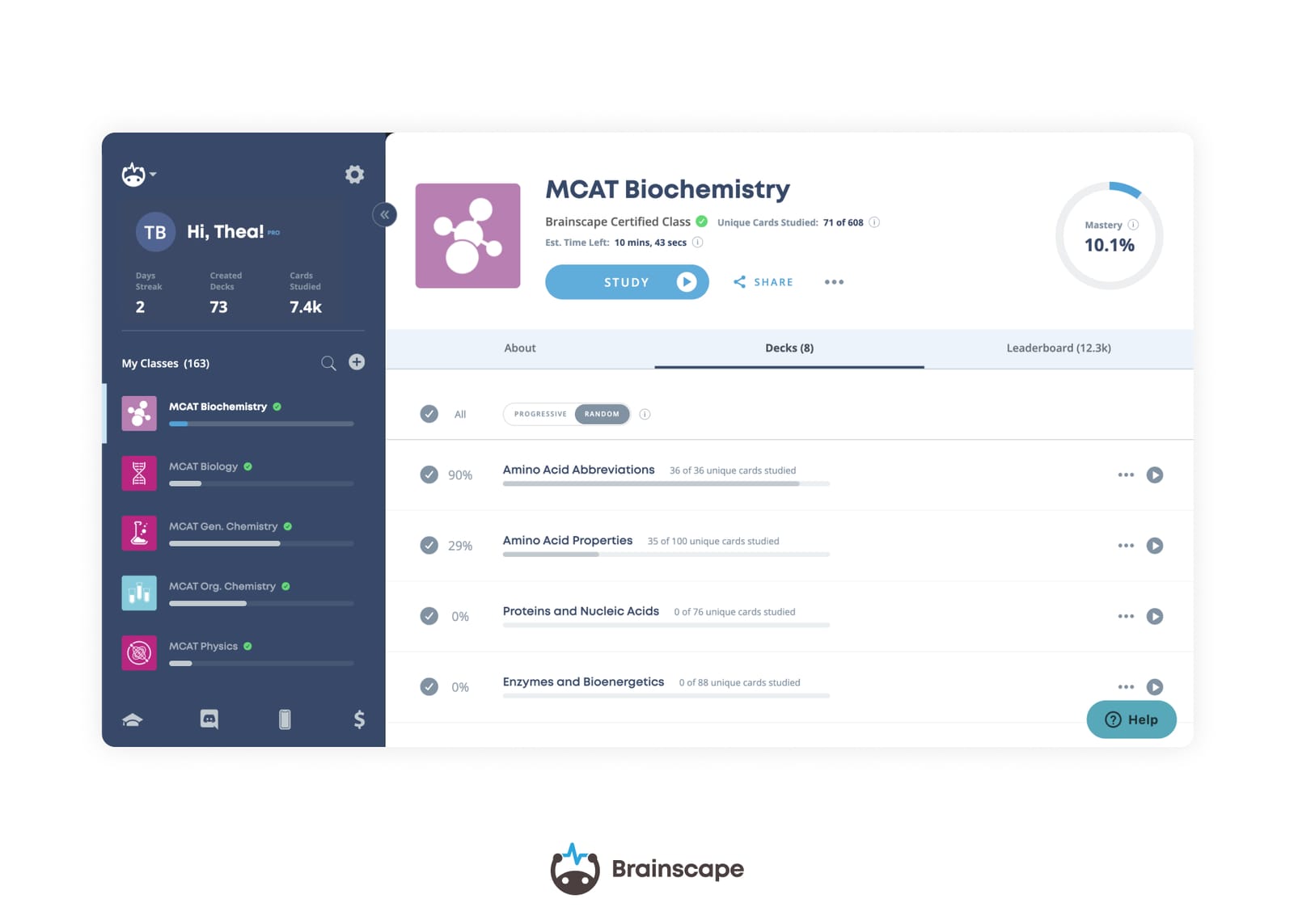Remember when you were a kid and your parents would make you practice your karate, violin, or ballet?
Practice makes perfect.
Or your teacher would hound you to do your multiplication tables?
Practice makes perfect.
Or your girlfriends would make out with each other?
Practice makes...wait, so that’s what girls get up to during slumber parties?
Turns out they were all onto something.
Practice is an essential part of mastering a skill, whether it’s a musical instrument, mathematics, or making out. This is just as true for the MCAT test, which not only assesses your science knowledge but also your critical thinking and reasoning skills.
As such, MCAT practice exams are a fundamental component of your preparation. The only thing is, while many students include MCAT tests in their prep, they only get a fraction of the full value out of them because they are missing out on several important practice principles.
That’s exactly what we’re here to address today. In this guide on how to take an MCAT practice test, we’re going to help you squeeze every last drop of benefit out of them so that your time is spent super efficiently and with the maximum ROI possible.
Hi! We’re Brainscape

We’re the brains, minds, and hearts behind the world’s smartest study app. You’ll be learning more about Brainscape during the course of this guide but for now, know that we’ve brought together some of the smartest people in the realm of the MCAT study to compile a comprehensive collection of study guides and digital flashcards for the MCAT.
These 4,200+ smart, digital flashcards cover the most important concepts in the AAMC MCAT curriculum, as well as those taught by Blueprint, Khan Academy, Gold Standard, Princeton Review, Exam Krackers, and other MCAT prep providers. So, no matter which test prep provider you're using, we've got you covered!

The lead author is Clara Gillan, Director of Product at MedSchoolCoach and 100th percentile MCAT-taker with a score of 526. In other words: she knows her sh*t! In this guide, Clara will be walking us through the following tips on the most profitable ways to take on practice MCAT tests, followed by the best free MCAT practice test resources out there:
- Tip 1: Take a full MCAT practice test right at the beginning of your prep
- Tip 2: Take each practice exam like it’s the real thing
- Tip 3: Be strict on timing yourself
- Tip 4: Use Brainscape to master the facts
- Tip 5: Understand that analysis skills are as important as content knowledge
- Tip 6: Read the passages and the questions carefully
- Tip 7: Spend time (a LOT of it) analyzing your practice test results
- Tip 8: Don’t forget to review the questions you got right, too!
- Tip 9: Identify and focus on your weaknesses
- Tip 10: Use reputable MCAT practice test resources
- Tip 11: Don’t freak out if you don’t do well on an MCAT practice test!
With that housekeeping out of the way, let’s jump in!
Tip 1: Take a Full MCAT Practice Test Right at the Beginning of Your Prep
It may seem to be the logical approach to study science content first and then, right before the MCAT, put your knowledge to the test by taking a couple of practice MCAT tests. But this is wrong. Leaving your MCAT practice for the end of your prep is one of the worst mistakes you can make. The earlier you start practicing, the better!
It doesn’t matter that you might not have your content knowledge down yet. What matters is that you experience an MCAT exam in all its micro and macroscopic glory so that you know exactly what you’re preparing for.
Taking a practice exam EARLY ON in your prep:
- Emphasizes the importance of honing both your content knowledge AND your critical thinking and reasoning skills;
- Allows you to tailor your MCAT study plan to help you prep efficiently and effectively;
- Alerts you to what your struggles might be when you take on the MCAT and, therefore, which of your skills or content areas you should take special care not to overlook;
- Gives you the time to prepare yourself mentally and physically to take on 7.5 hours’ worth of exam.
There is a ton of learning you need to do as an MCAT candidate, and this needs to begin on DAY ONE with a rude awakening, which you can then use to plot the best and most efficient path forward until you are more confident than Bruce Lee walking into a bar full of drunken idiots. And the more practice and exposure you get throughout your MCAT prep, the more prepared you’ll feel and be.
Tip 2: Take Each Practice Exam Like It’s The Real Thing

As we mentioned above, a significant part of the challenge of taking on the MCAT is the physical and mental toll this 7.5-hour exam exacts upon your brain and body. The best way to prepare for this is to actually experience the challenge, which you can do by taking an MCAT practice test like it’s the real thing.
You don’t have to do ALL of your MCAT practice under rigorously timed, test-like conditions. Working through individual CARS passages untimed at the beginning of your prep can have benefits, as can studying at times that don’t perfectly reflect your test-day itinerary. But when it comes to MCAT practice tests, representative conditions are important. Don’t shortchange yourself here!
So, find or create a distraction-free space, turn off any unnecessary devices, put away all of your notes and textbooks, and do the damn thing! If you start feeling fatigued or restless, just remember: this is probably how you’re going to feel on the day of the exam, so try to come up with mental exercises to remain focused.
Also, take note of what your body needs: water, food, tissues, a warmer sweater, less uncomfortable shoes, etc. You don’t want chattering teeth or hunger pangs to plague you throughout your exam. Similarly, learn what important items you won’t be allowed to bring into the testing room, like chapsticks. You can still go out to your storage locker on breaks on exam day, so practice using those items only during those specific times.
If you’re disturbed by minor things like shuffling papers, loud breathing, or a humming air conditioner, don’t AVOID them in your MCAT practice ... rather, try to become used to them because you very well may encounter these distractions in the real MCAT venue. Better yet, invest in a pair of noise-canceling earphones. While you won’t be allowed to take them into the testing center with you, the examiners do provide optional earphones, so if you plan on using them, you’d better get comfortable with your own first.
Tip 3: Be Strict On Timing Yourself
Hand-in-hand with the previous point, time your MCAT practice, adhering strictly to the time limits in place for the four major sections:
- Biological and Biochemical Foundations of Living Systems: 95 minutes
- Chemical and Physical Foundations of Biological Systems: 95 minutes
- Psychological, Social, and Biological Foundations of Behavior: 95 minutes
- Critical Analysis and Reasoning Skills: 90 minutes
Of course, if the AAMC has granted you testing accommodations, your allotted time may be different, so it’s best for you to practice with those time limits instead. (If you have no idea what we’re talking about here, use the times specified above.) And either way, try not to pause the exam! Most MCAT practice test systems will let you do it, but it’s not allowed on the real exam, and relying on it during practice can be a very slippery slope.
If you struggle to get through everything within these time limits, it’s imperative that you work on your time management skills. With every MCAT practice test, try to improve on your efficiency so that, come D-Day, you can work swiftly and decisively through each section and even have time left over to double-check your answers!
Tip 4: Use Brainscape To Master The Facts
There is a mountain of knowledge you need to master in order to take on the mighty MCAT test, and the best supplementary study tool to help you get the job done is Brainscape.

Our panel of MCAT supernerds and 100th percentilers have distilled the entire Association of American Medical Colleges (AAMC) curriculum down into a collection of 4,200+ neatly organized flashcards, which you can study anywhere, anytime via the web or our mobile app. These flashcards cover every MCAT science subject, with a special focus on high-yield topics, such as experimental design, analytic techniques, amino acids, and more.
They also cover the highest-yield concepts taught by Blueprint, Khan Academy, Gold Standard, Princeton Review, Exam Krackers, and other MCAT prep providers. So, no matter which one you're using, we've got you covered!
The real secret sauce behind the success of Brainscape is our adaptive learning platform, which leverages decades of cognitive science research to help students study TWICE as efficiently as traditional study methods and target their knowledge weaknesses.
Also, our spaced repetition algorithm will ensure that you focus on your weaknesses without wasting time on the content you already know, and yet review all the content enough so that it doesn’t fade from memory.

Brainscape’s MCAT flashcards are a powerful review tool to help you master the facts you need to ace the exam, so we really recommend you add them to your arsenal of study strategies!
Get Brainscape’s certified MCAT flashcards!
Tip 5: Understand That Analysis Skills Are As Important As Content Knowledge
Brainscape can help you with your content knowledge, but the MCAT focuses just as much on assessing your critical analysis and reasoning skills (in the science sections, too, not just CARS) as it does content. And since these skills are gained, honed, and perfected through practice, the best way to prepare is to do as many full-length MCAT practice exams and CARS (critical analysis and reasoning skills) passages as you can reasonably fit into your schedule.
(Note that “reasonably” is the operative word here. With full-length exams, more isn’t always better! We typically recommend completing six to eight, although that number can be bumped up or down depending on the length of your study plan. Going into your prep planning on taking forty full-lengths—even if you can find them—is not a good bet.)
Sure, you’ll never see the same exact passage again (unless you retake that practice test later), but MCAT passages are much more similar than you might think. Every time you do one, you’ll sharpen your skills, widen your experience, and train your brain to dissect and analyze the scenarios laid out before you.
Rather than treating each passage as a one-off, understand that it likely resembles (in at least some ways) passages you WILL see on your exam, and proceed accordingly. This will prove enormously beneficial when you take the real MCAT test.
Tip 6: Read The Passages And The Questions Carefully

This seems obvious because it is. And yet soooo many MCAT students miss this point, either because of anxiety (“OMG, I need to read this passage in 30 seconds!”) or because of flawed strategies such as “skimming,” passage triaging, or reading the questions first.
Yes, you might have to read a passage super fast if you’re running out of time. But don’t make it a habit for the exam as a whole. It’s generally best to take a few minutes to read each passage, in both the science sections and CARS. Trying to save time by speed-reading often ends up doing the opposite when you have to spend minutes searching for relevant info while answering the questions.
Regarding the flawed strategies we mentioned, debunking them would be a separate article in itself, but essentially, their goal is to give you a “leg up” on the test by selectively skipping hard passages or de-emphasizing the passage itself. This can seem tempting! After all, doesn’t it make sense to look at the questions first, to see what parts of the passage you even need to care about?
The problem is that this prevents you from reading and synthesizing the passage as a whole, a skill that the MCAT test-writers are very eager to test. As simple and boring as it is, the best MCAT test-taking strategy is to read each passage, then its questions, in the order they’re presented.
Finally, it’s INCREDIBLY common for students to miss a single word when reading a question (especially keywords like “except” or “least”). As you’d expect, this is soul-crushing during the review, because your reasoning may be perfect...but your answer choice is the opposite of the correct one. Don’t make the same mistake. Read the passages and questions carefully, particularly in the CARS section.
Tip 7: Spend Time (a LOT of it) Analyzing Your Practice Test Results
If you want to get maximum value out of your resources, taking a full-length MCAT practice test is only the very beginning. It’s actually even more important to take the time to work through your results so that (1) you reinforce the content knowledge and analysis skills you used correctly, thereby helping you respond more decisively the next time you see a similar question/s; and (2) you understand why you got wrong what you did and how you can do better next time.
This is where really valuable learning takes place. If you’re not carefully working through your practice test results, you are missing out on a significant portion of the value of taking them in the first place! How else are you supposed to learn from your mistakes?
And when we say “carefully,” we really mean it. We recommend spending at least as much time reviewing each practice exam as you did taking it in the first place. That’s 7.5 hours for review, or even more!
In our experience, the students most likely to be disappointed with their MCAT score correlate extremely closely with those who rushed the review process. Spending 3 to 4 hours reviewing an exam might not seem like rushing … but with the MCAT, it is. This is why we suggested (earlier and now again) that you don’t pack additional practice exams in your schedule unless you know you’ll also have time to review them.
And don’t skip sections, either! As tempting as it often is to avoid reviewing the CARS section, doing so can give you insights that carry far beyond those individual passages and questions, especially with regard to wrong answers that you tend to fall for.
Pro Tip: Use Brainscape’s MCAT flashcards to help you brush up on the concepts and facts you struggle with the most. Alternatively, you can even make your own flashcards for the particular facts you got wrong in your practice tests.
Tip 8: Don’t Forget To Review The Questions You Got Right, Too!
Imagine that you’re well into the swing of your MCAT study plan. You’re taking MCAT practice exams and reviewing them over eight grueling hours. You’re paying careful attention to what you missed and why, but things still aren’t quite clicking. There may be a simple reason for this: you aren’t reviewing the questions you got correct just as carefully.
It’s easy to think that this might be unnecessary. After all, why focus on what you already know? But this line of reasoning leaves a tremendous amount of value untapped.
For one, you might have guessed correctly on certain questions and still have no idea how to answer them. Or maybe you thought you understood the question, stumbled into a correct answer, but actually used misguided reasoning. Finally, perhaps you got the question right for the right reasons, but the explanation may bring up an alternate way to approach it that could help build your MCAT skills from good to better.
For this reason, review every single question, right or wrong, to really supercharge your MCAT practice test review.
Tip 9: Identify And Focus On Your Weaknesses
With practice exams, it can be tempting to pass over the questions you don’t know and just hope and pray you never see that question or topic again. If you want to retake the MCAT, this is an excellent strategy.
Since you probably don’t (unless you are avoiding becoming an adult), a much better approach is to pay special attention to the questions and concepts you struggle with and practice that skill or content until it’s as muscular as the rest of your ken.
Use your MCAT test result reconnaissance to identify whether the problems you had were more content-based or skills-based. Did you misunderstand the question or incorrectly dissect the passage? Or did you get it wrong because you didn’t know the supporting content well enough?
If your problem is more related to content, it’s important that you take an hour or two to review that topic. If it’s skills-based, first identify WHAT that skill is. Are you having trouble going back to the right part of the passage? Do you tend to reflexively look at graphs and ignore other passage content? Or are you missing questions involving unit conversions?
Of course, these are only a few of the myriad MCAT reasoning skills you need, but you get the picture. Identifying what went wrong is a prerequisite step to understanding what to do next. And of course, more practice can’t hurt!
Tip 10: Use Reputable MCAT Practice Test Resources

It’s the Wild, Wild West out there on the Internet, and as a result, anyone’s aunt or cousin-twice-removed can publish free MCAT practice test resources, with the goal of luring you in and selling something to you.
Furthermore, the lack of vetting or accreditation of these resources means there are some pretty crappy practice exams out there, some of which could go as far as seriously harming your MCAT prep: firstly, by wasting your time; secondly, by confusing you with their poorly worded passages and questions; and thirdly, by damaging your confidence.
As such, we recommend you use respected, accredited resources such as the AAMC’s five full-length practice tests (including a free MCAT practice test) and their other resources, such as the Section Bank, Question Packs, and the often-overlooked Official Guide questions.
Don’t get us wrong: we’re not saying that all practice tests other than these are problematic. The main points that distinguish reputable MCAT resources from the herd are quality content production and a commitment to revision and review. If you aren’t sure whether a certain resource is reliable, dig into online reviews, or even ask that company how they developed it.
Tip 11: Don’t Freak Out If You Don’t Do Well On An MCAT Practice Test!
This is a super important morsel of advice because just about everyone who’s ever taken an MCAT practice test and scored unexpectedly low is guilty of it: Do not freak out!
Yes, it’s tempting to see a practice MCAT test as a preview of the real MCAT and, therefore, of your final score. But there’s a reason you’re taking these tests in the first place, and that’s to hone your skills, perfect your content knowledge, and prepare yourself mentally and physically to take on the real deal.
It’s also important to emphasize that score improvement is almost never linear. The vast majority of students experience a score drop sometime in the process. This brief score decrease is particularly common early on, often between the first and second practice exam you take.
This is demoralizing—“haven’t I improved at all?”, you might think—but it generally doesn’t mean much. In fact, paradoxically, such decreases can be indicators that you’ve learned MCAT-style reasoning just enough to fall into traps that you were too MCAT-unsavvy to even notice before. Long plateaus (or periods of being stuck at the same score) are also common.
What’s important is that you learn from each and every question you got wrong so that you’re unlikely to make that mistake again. At the same time, as we indicated earlier, it’s just as important that you review the questions you got right so that (1) your content knowledge and skills in those areas are positively reinforced and (2) you see real evidence of how well you’re doing, which will help offset the stress caused by getting some questions wrong.
You could even do an entirely positive review of a practice test, in which you bathe in the glory of all the questions you got right and pat yourself on the back until you inadvertently burp. This will allow you to build your confidence up again and banish your MCAT anxiety.
MCAT Practice Makes Perfect
Yes, practice does make perfect. But as with most other skills, learning how to practice the right techniques and tricks is equally as important as the amount of time you invest in that practice. After reading all of the tips in this guide (summarized below), you should definitely have all the intel you need to go forth and engage in highly profitable MCAT practice.
- Tip 1: Take a full MCAT practice test right at the beginning of your prep
- Tip 2: Take each practice exam like it’s the real thing
- Tip 3: Be strict on timing yourself
- Tip 4: Use Brainscape to master the facts

- Tip 5: Understand that analysis skills are as important as content knowledge
- Tip 6: Read the passages and the questions carefully
- Tip 7: Spend time (a LOT of it) analyzing your practice test results
- Tip 8: Don’t forget to review the questions you got right, too!
- Tip 9: Identify and focus on your weaknesses
- Tip 10: Use reputable MCAT practice test resources
- Tip 11: Don’t freak out if you don’t do well on an MCAT practice test!
For the world's fastest memorization system, make sure you lock in our certified MCAT flashcards as a steady part of your study plan. With Brainscape, the ultimate study weapon, on your side, you'll be sure to crush the MCAT!
